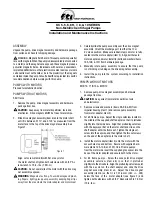
506 01 2303 01
29
Specifications are subject to change without notice.
SERVICE
Refrigeration System
EQUIPMENT DAMAGE HAZARD
Failure to follow this caution may result in damage to
equipment .
This system uses R--410A refrigerant which has higher
pressures than R--22 and other refrigerants. No other
refrigerant may be used in this system. Gage set,
hoses, and recovery system must be designed to
handle R--410A. If you are unsure consult the
equipment manufacturer.
CAUTION
!
Compressor Oil —
EQUIPMENT DAMAGE HAZARD
Failure to follow this caution may result in damage to
equipment .
The compressor in a R--410A system uses a polyolester
(POE) oil. This oil is extremely hygroscopic, meaning it
absorbs water readily. POE oils can absorb 15 times as
much water as other oils designed for HCFC and CFC
refrigerants. Take all necessary precautions to avoid
exposure of the oil to the atmosphere.
CAUTION
!
Servicing Systems on Roofs with Synthetic Materials —
POE (polyolester) compressor lubricants are known to
cause long term damage to some synthetic roofing
materials. Exposure, even if immediately cleaned up, may
cause embrittlement (leading to cracking) to occur in one
year or more. When performing any service which may
risk exposure of compressor oil to the roof, take
appropriate precautions to protect roofing. Procedures
which risk oil leakage include but are not limited to
compressor replacement, repairing refrigerants leaks,
replacing refrigerant components such as filter drier,
pressure switch, metering device, coil, accumulator, or
reversing valve.
Synthetic Roof Precautionary Procedure:
1. Cover extended roof working area with an imperme-
able polyethylene (plastic) drop cloth or tarp. Cover
an approximate 10 x 10 ft (3.3 x 3.3 m) area.
2. Cover area in front of the unit service panel with a
terry cloth shop towel to absorb lubricant spills and
prevent run-offs, and protect drop cloth from tears
caused by tools or components.
3. Place terry cloth shop towel inside unit immediately
under component(s) to be serviced and prevent lubri-
cant run-offs through the louvered openings in the
base pan.
4. Perform required service.
5. Remove and dispose of any oil contaminated material
per local codes.
Liquid Line Filter Drier —
The factory-provided reversible filter drier is specifically
designed to operate with R--410A. Replace the filter drier
with factory-authorized components only with a filter
drier with desiccant made from 100% molecular sieve
grade XH-11. Filter drier must be replaced whenever the
refrigerant system is opened.
When removing a filter drier, use a tubing cutter to cut the
drier from the system.
Do not unsweat a filter drier
from
the system. Heat from unsweating will release moisture
and contaminants from drier into system.
Field Refrigerant Access Ports —
Field service access to refrigerant pressures is through the
access ports located at the service valves (see Figs 28, 30
and 32). These ports are
-in SAE Flare couplings with
Schrader check valves and service caps. Use these ports to
admit nitrogen to the field tubing during brazing, to
evacuate the tubing and evaporator coil, to admit initial
refrigerant charge into the low-side of the system and
when checking and adjusting the system refrigerant
charge. When service activities are completed, ensure the
service caps are in place and secure; check for leaks. If
the Schrader check valve must be removed and
re-installed, tighten to 2-3 in-lbs (23-34 N-cm).
Outdoor Coil Metering Devices —
The metering devices are multiple fixed–bore devices
(Acutrol
) swaged into the horizontal outlet tubes from
the liquid header, located at the entrance to each outdoor
coil circuit path. These are non–adjustable. Service
requires replacing the entire liquid header assembly.
To check the outdoor coil, disconnect the outdoor fan
motor. Start the circuit in a Heating Mode (jumper R to
W1) and observe the frost pattern on the face of the
outdoor coil. A frost pattern should develop uniformly
across the face of the outdoor coil starting at each tube at
the Acutrol nipple locations.
Failure to develop frost at an outlet tube can indicate a
plugged or a missing orifice.
















































